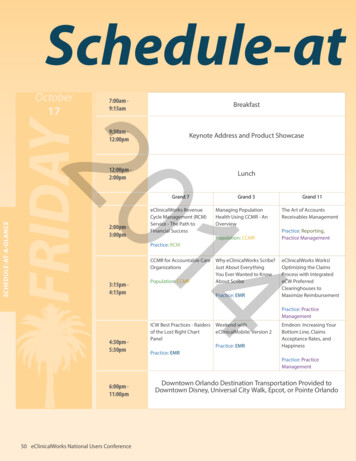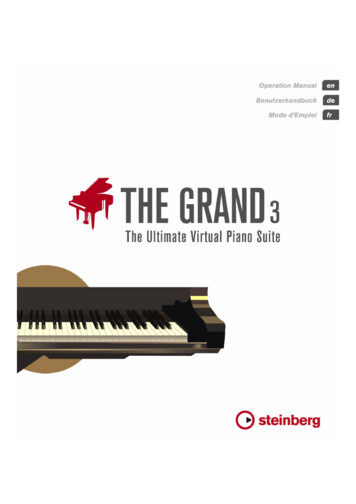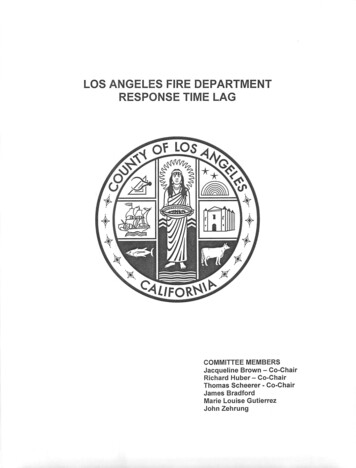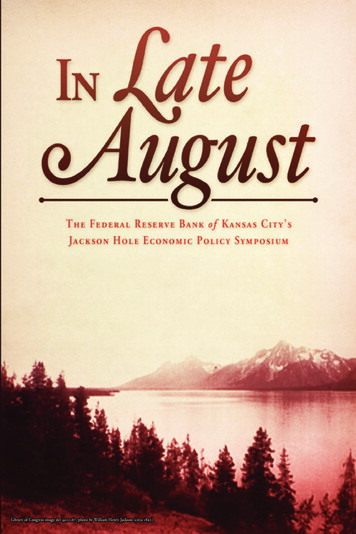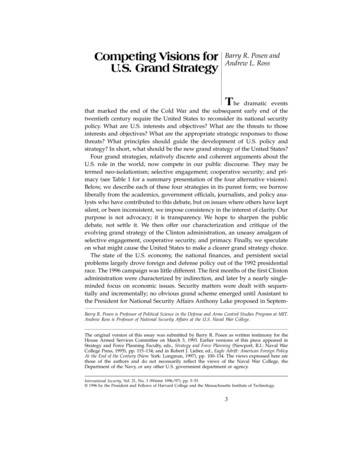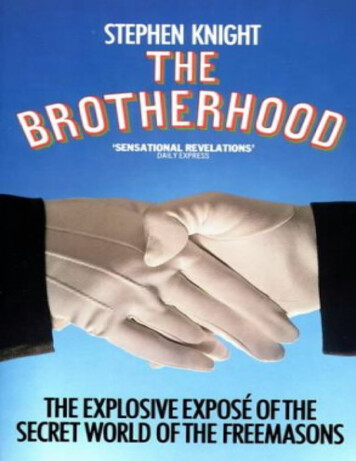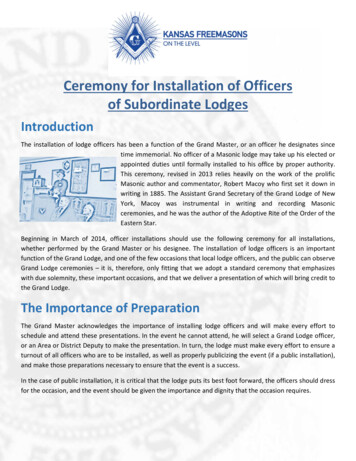
Transcription
Strategy andGrand Strategy:WhatStudents andPractitionersNeed to KnowTami Davis BiddleUNITED STATESARMY WAR COLLEGEPRESSCarlisle Barracks, PAandADVANCINGSTRATEGIC THOUGHTSERIES
The United States Army War CollegeThe United States Army War College educates and develops leaders for serviceat the strategic level while advancing knowledge in the global applicationof Landpower.The purpose of the United States Army War College is to produce graduateswho are skilled critical thinkers and complex problem solvers. Concurrently,it is our duty to the U.S. Army to also act as a “think factory” for commandersand civilian leaders at the strategic level worldwide and routinely engagein discourse and debate concerning the role of ground forces in achievingnational security objectives.The Strategic Studies Institute publishes nationalsecurity and strategic research and analysis to influencepolicy debate and bridge the gap between militaryand academia.CENTER forSTRATEGICLEADERSHIPU.S. ARMY WAR COLLEGEThe Center for Strategic Leadership contributesto the education of world class senior leaders,develops expert knowledge, and provides solutionsto strategic Army issues affecting the nationalsecurity community.The Peacekeeping and Stability Operations Instituteprovides subject matter expertise, technical review,and writing expertise to agencies that develop stabilityoperations concepts and doctrines.The School of Strategic Landpower develops strategicleaders by providing a strong foundation of wisdomgrounded in mastery of the profession of arms, andby serving as a crucible for educating future leaders inthe analysis, evaluation, and refinement of professionalexpertise in war, strategy, operations, national security,resource management, and responsible command.The U.S. Army Heritage and Education Center acquires,conserves, and exhibits historical materials for useto support the U.S. Army, educate an internationalaudience, and honor soldiers—past and present.i
STRATEGICSTUDIESINSTITUTEThe Strategic Studies Institute (SSI) is part of the U.S. Army WarCollege and is the strategic-level study agent for issues relatedto national security and military strategy with emphasis ongeostrategic analysis.The mission of SSI is to use independent analysis to conductstrategic studies that develop policy recommendations on: Strategy, planning, and policy for joint and combinedemployment of military forces; Regional strategic appraisals; The nature of land warfare; Matters affecting the Army’s future; The concepts, philosophy, and theory of strategy; and, Other issues of importance to the leadership of the Army.Studies produced by civilian and military analysts concerntopics having strategic implications for the Army, the Department ofDefense, and the larger national security community.In addition to its studies, SSI publishes special reports on topicsof special or immediate interest. These include edited proceedingsof conferences and topically oriented roundtables, expanded tripreports, and quick-reaction responses to senior Army leaders.The Institute provides a valuable analytical capability within theArmy to address strategic and other issues in support of Armyparticipation in national security policy formulation.iii
Strategic Studies InstituteandU.S. Army War College PressSTRATEGY AND GRAND STRATEGY:WHAT STUDENTS AND PRACTITIONERS NEEDTO KNOWTami Davis BiddleDecember 2015The views expressed in this report are those of the author anddo not necessarily reflect the official policy or position of theDepartment of the Army, the Department of Defense, or the U.S.Government. Authors of Strategic Studies Institute (SSI) andU.S. Army War College (USAWC) Press publications enjoy fullacademic freedom, provided they do not disclose classifiedinformation, jeopardize operations security, or misrepresentofficial U.S. policy. Such academic freedom empowers them tooffer new and sometimes controversial perspectives in the interest of furthering debate on key issues. This report is cleared forpublic release; distribution is unlimited.*****This publication is subject to Title 17, United States Code,Sections 101 and 105. It is in the public domain and may not becopyrighted.v
*****Comments pertaining to this report are invited and shouldbe forwarded to: Director, Strategic Studies Institute and U.S.Army War College Press, U.S. Army War College, 47 AshburnDrive, Carlisle, PA 17013-5010.*****All Strategic Studies Institute (SSI) and U.S. Army WarCollege (USAWC) Press publications may be downloadedfree of charge from the SSI website. Hard copies of certainreports may also be obtained free of charge while supplies lastby placing an order on the SSI website. Check the website foravailability. SSI publications may be quoted or reprinted inpart or in full with permission and appropriate credit givento the U.S. Army Strategic Studies Institute and U.S. ArmyWar College Press, U.S. Army War College, Carlisle, PA. Contact SSI by visiting our website at the following **The Strategic Studies Institute and U.S. Army WarCollege Press publishes a monthly email newsletter to updatethe national security community on the research of our analysts,recent and forthcoming publications, and upcoming conferences sponsored by the Institute. Each newsletter also providesa strategic commentary by one of our research analysts. If youare interested in receiving this newsletter, please subscribe on theSSI website at ISBN 1-58487-714-6vi
FOREWORDThere is no word or phrase more important andessential to the national security community than“strategy.” In this monograph, Dr. Tami Davis Biddleargues that, while most of us have a sense of what theword means, we do not always fully appreciate allthat it entails and all that it demands of us. Indeed, sheargues that because strategy is so difficult on so manylevels, we must not delude ourselves into believingthat it can be practiced in any idealized form. But sheinsists that in situations where lives are at stake, wehave a moral obligation to do all we can to meet thewide array of challenges we must face as we deviseand implement strategies (and grand strategies) toachieve desired political ends.Dr. Biddle begins her monograph with a close examination of the terms “strategy” and “grand strategy.” Relying on a wide body of literature by historians,political scientists, and practitioners, she examinesthe reasons why political actors adopt strategies andgrand strategies, and she helps us understand howthe terms have been used—and have evolved—overtime. She observes that the way in which strategiesand grand strategies have been developed and implemented by actors in the international system hasfollowed a narrative arc determined largely by thechanging character, over time, of social, political, andmilitary organizations.Relying on this definitional and historical groundwork, Dr. Biddle articulates the myriad reasons whythe practice of strategy is such a difficult and demanding art. She argues that strategy requires a logic thatcan be explained and defended, but points out that often this logic rests on assumptions that have not beenvii
thoroughly and rigorously examined. She argues that,even when the logic of strategy makes sense, its implementation will be eroded and undermined by contending interests and bureaucratic politics; unforeseenand unanticipated events; the pressures of domesticpolitics; the limits of human cognition, attention, andendurance; and the ongoing challenges posed by civilmilitary interaction.Dr. Biddle’s clear-headed examination of strategy,which is full of useful examples and sober guidance,will sharpen the analytical skills and deepen the situational awareness of students and practitioners alike.DOUGLAS C. LOVELACE, JR.DirectorStrategic Studies Institute andU.S. Army War College Pressviii
ABOUT THE AUTHORTAMI DAVIS BIDDLE is Professor of National Security at the U.S. Army War College (USAWC), in Carlisle, PA. She was the Hoyt S. Vandenberg Professorof Aerospace Studies at the USAWC from 2011-13.Prior to that, she was the 2005-07 George C. MarshallProfessor of Military Studies at the USAWC and the2001-02 Harold K. Johnson Visiting Professor of Military History at the U.S. Army’s Military History Institute. Before coming to the USAWC, she taught in theDepartment of History at Duke University, where shewas a core faculty member of the Duke-University ofNorth Carolina Joint Program in Military History. Sheis a member of the Board of Trustees of the Society forMilitary History. Dr. Biddle’s research focus has beenwarfare in the 20th century, in particular the history ofair warfare. She also studies and writes about militaryorganization and leadership, civil-military relations,grand strategy, national security policy, and professional military education. Dr. Biddle’s book, Rhetoric and Reality in Air Warfare: The Evolution of Britishand American Ideas about Strategic Bombing, 1914-1945(Princeton, NJ: Princeton University Press, 2002) was aChoice Outstanding Academic Title for 2002 and wasadded to the Chief of Air Staff’s Reading List, RoyalAir Force. Recently, she wrote the chapter on strategicbombing for the Cambridge History of the Second WorldWar (2015). Other publication credits include: “Leveraging Strength: The Pillars of American Grand Strategy in World War II” in Orbis, Winter 2011; “Dresden1945: Reality, History, and Memory,” in The Journal ofMilitary History, Vol. 72, No. 2 (April 2008); and “TheRole of Military History in the Contemporary Academy,” a Society for Military History White Paper (2014),ix
written with Robert M. Citino. Dr. Biddle has held fellowships from Harvard, the Social Science ResearchCouncil, and the Smithsonian Institution’s NationalAir and Space Museum, and she holds a Ph.D. inhistory from Yale University.x
SUMMARYIn this monograph, Dr. Tami Davis Biddle examines why it is so difficult to devise, implement, andsustain sound strategies and grand strategies. Heranalysis begins with an examination of the meaningof the term “strategy” and a history of the ways thatpolitical actors have sought to employ strategies andgrand strategies to achieve their desired political aims.She examines the reasons why the logic undergirdingstrategy is often lacking and why challenges of implementation (including bureaucratic politics, unforeseenevents, civil-military tensions, and domestic pressures) complicate and undermine desired outcomes.This clear-headed critique, built on a broad base of literature (historical and modern; academic and policyoriented), will serve as a valuable guide to studentsand policymakers alike as they seek to navigate theirway through the unavoidable challenges—and inevitable twists and turns—inherent in the developmentand implementation of strategy.xi
STRATEGY AND GRAND STRATEGY:WHAT STUDENTS AND PRACTITIONERSNEED TO KNOWTami Davis BiddleThe contemporary word “strategy” came to usfrom ancient Greece, where it referred to the art orskill of the general. In this original iteration, it wascloser to what we now call “tactics.”1 The word hasevolved over time and has been subjected to stretchingand pulling. It has been appropriated by a wide rangeof actors—many of whom have had little or nothingto do with either the military or national security. Indeed, the word “strategy” is so widely used today thatone may see it applied to everything from warfightingto the marketing of beverages.2 Often it is used as asubstitute or synonym for the rather more basic term“plan.” Moreover, there is no standard contemporarydefinition of the term (or the related phrase “grandstrategy”) embraced by those who write about national security and international affairs. Even withinthis realm, there are definitional differences that varyby discipline and reference group. For instance, political scientists often use the phrase “grand strategy”to discuss what historians might refer to, instead, asa general framework for foreign policy, such as neoisolationism, selective engagement, or primacy.3Because this lack of consensus can lead to confusion, it is essential for scholars or practitioners whostudy and/or work in the realm of international security to articulate their own definition of the terms“strategy” and “grand strategy,” or to select fromamong the many available in the existing literature.Students of international security need to think hard1
about the history and meaning of strategy, and reflect on what it demands of the practitioner. Studentswho proceed beyond academic study and attempt topractice the art of strategy will quickly gain a healthyrespect for the myriad challenges it poses.The purpose of this monograph is to give the student of strategy an anchor point—a foothold that canbe used as a foundation for further analysis and primerfor work in the practical realm. After offering definitions that I find helpful, I explain why political actorstraditionally have sought to develop strategies andgrand strategies to guide their behavior in the international system. I then examine the evolution of strategyand grand strategy in history. Finally, and most importantly, I examine the myriad challenges one mustface in developing and implementing strategy andgrand strategy. These challenges exist for many reasons, not the least of them being that strategy demandsa theory—a proposed causal explanation—that muststand up to rigorous analysis. A theory, in its most basic form, can be expressed as: “if x, then y.” Thus, thestrategist must be able to defend the statement, “If weuse resource X, then we will achieve objective Y” (“orat least move in the direction of achieving objectiveY”). But the word “then” carries a heavy burden sinceit must be able to do a lot of work and bear intenseevaluation—and this scrutiny must include, above all,the close examination of one’s assumptions since theseserve as the building blocks of the causal relationshiplinking ends and means. Strategy rests on assumptions; if assumptions go unexamined, then one risksbuilding a strategic edifice on a foundation of sand.4Often, however, such scrutiny does not take place,either because no one takes the time for it or becauseit would question or challenge organizational culture2
or individual preferences. Too often, the explanatorylogic of strategy ends up being little more than anorganizational mantra, or a facile assertion about theoverwhelming power of a particular military instrument, or the easy opportunity presented by an enemy’s presumed frailties. When faced with an unanticipated crisis, political decisionmakers may grab for thefirst option that looks even vaguely plausible in orderto keep domestic critics at bay—especially those whowould charge them with being unresponsive and/or weak. The laws of cognitive psychology will be atwork (as they are in all human endeavors): the actorsinvolved will “see what they want to see,” filtering outdisconfirming data or evidence that causes individualor institutional stress.5A seasoned strategist knows that linking objectivesand resources requires—indeed demands—doinghomework. If, for instance, one wants to convince a rival state to make a concession, then one must assess (ata minimum) the stakes involved for both parties andthe willingness of their populations to pay a price orendure sacrifices for the sake of the interest involved.One must assess the nature of the adversary, including its political and social composition and structure,the resiliency of that structure, and the robustness ofits popular and elite will. One must understand theadversary’s domestic politics, and the nature of the relationships between the population, the government,and the military.6 Finally, one must assess one’s owninstruments of power available for persuasion and coercion—including whether or not they are available,acceptable, and well-suited to the purpose for whichthey will be used. These questions, though crucial, areonly a starting place since each one raises additionalquestions to pose and answers to obtain. The work is3
painstaking and demanding, but the cost of shortcutscan be very high—even catastrophic.7Even if one’s assumptions are sound and if the logicof strategy makes sense on a fundamental level, manyfactors will intrude to erode or break the link betweenmeans and ends. These will include the challenges ofcommunication inherent in complex enterprises; theadaptability of one’s adversary; the complications ofdomestic politics; the stresses and strains of civil-military relations; and the unavoidable biases, predispositions, and limitations of the agencies attempting toimplement the strategy.8The student of strategy who also seeks to becomean effective practitioner of this difficult art must prepare to develop such qualities as patience, empathy,judgment, and, above all, the resilience and determination to rebound from the inevitable and repeatedsetbacks that are inherent in the enterprise. Paul Kennedy has pointed out, perceptively, that grand strategy in particular relies upon “the constant and intelligent reassessment of . . . means and ends; it reliesupon wisdom and judgment.”9WORDS AND MEANINGSWithin the military, there is a hierarchy of termsthat define and delineate specific activities related totactics and strategy; they are nested like a set of Russian dolls, with each one referring to a particular bandof action and responsibility. They begin with “tactics”at the lowest level, and move upward and outwardto “grand strategy” at the highest level. Because theseterms must be comprehended and used consistentlyby large groups of people, they have official definitionsand are incorporated into formal service doctrine. In4
general, “tactics” describe how small units (platoons,companies, ships, and squadrons) are to be employedin a battle space. Moving up one notch, “operations”(and “operational art”) concern the movement oflarger military units, including army divisions, navaltask forces, and wings of aircraft. “Theater strategy”concerns the direction of the largest military units ina battle space, including armies and army groups, naval fleets, and numbered air forces.10 Theater strategy(also referred to as military strategy) “prescribes howmilitary instruments per se are to achieve the goals setfor them by grand strategy within a given theater ofwar.”11 At the top of the definitional hierarchy, “grandstrategy” identifies and articulates a given political actor’s security objectives at a particular point intime and describes how they will be achieved usinga combination of instruments of power—includingmilitary, diplomatic, and economic instruments. JohnLewis Gaddis has described grand strategy as “the calculated relationship of means to large ends. It’s abouthow one uses whatever one has to get to wherever itis one wants to go.”12In an effort to clarify these relationships, notedhistorian Samuel Eliot Morison wrote many yearsago that:General Lee’s decision to cross the Potomac into Maryland in 1862 was strategy, but the manner in which hefought General McClellan at Antietam was tactics. TheBritish decision in 1942 to hang on in the desert west ofEgypt was a matter of strategy; whilst General Montgomery’s directives for the Battle of El Alamein, andthe execution thereof, were tactical.5
Morison added that “Bad strategy can render the mostbrilliant tactics fruitless . . . Conversely, sound tacticsare necessary to implement good strategy.”13Theater strategy and grand strategy form the backbone of the curriculum at senior staff colleges insidethe U.S. military’s professional military educationsystem, where practitioners study the many elementsshaping the highest level of their art. Faculty membersat these colleges understand and use the word “strategy” in roughly similar ways.14 They perceive its central idea as the intelligent identification, utilization,and coordination of resources (ways and means) forthe successful attainment of a specific objective (end).15While this sentence implies a direct and easily comprehended relationship, the simplicity is deceptive.Barriers to creating a straightforward linkage betweenends, ways, and means are not only very real, but alsomultifaceted and persistent. This fact poses challengesfor the way that strategy and grand strategy is taughtin an academic setting. A framework that uses “ends,ways, and means” is not a bad way to enter into adiscussion of strategy since it gives students a chanceto gain initial traction as they begin their analysis.However, it is not enough to simply posit a calculatedrelationship between ends and means, assuming thatoptimal means and ends can be readily identified andthat the relationship between utilizing a particular resource (or combination of them) and achieving a political aim will be straightforward, easily articulated,or uncomplicated to implement.Recently, the teaching of strategy in the professional military education system has been criticizedon the ground that it fails to capture the complexitiesof the way that strategy and grand strategy are created and implemented in the real world. A RAND6
study led by Linda Robinson argued the U.S. militaryis taught to expect a linear approach in which the policymakers provide the objectives and the military develops the options for achieving them.16 Instead, theauthors argue, “Civilian policymakers require an active dialogue with the military and other sources ofinformation to inform the diagnosis of the situation,as well as to develop realistic policy objectives.” Theauthors add that there is a need for an “establishedintegrated civilian-military process that would rigorously identify assumptions, risks, possible outcomes,and second-order effects through soliciting diverseinputs, red-teaming, and table-top exercises.”17The argument raises some important questionsabout how one identifies civilian and military roles ina system shaped by what Samuel Huntington called‘objective control’ of the military, which requires adelineation between civilian and military realms ofprofessional competence.18 But the critique is surelyan important one that ought to inform pedagogy, notonly in the professional military education (PME)system, but also beyond. Military and civilian leaders need to comprehend one another’s professionalrealms well enough to be able to work together to produce coherent strategy. On the military side, officersmust acquire political acumen without political assertiveness. They must understand the political environment they work in well enough to be effective whileresisting any temptation toward political meddling.19This is a non-trivial challenge, but it is central to soundcivil-military relations and to the kind of strategy thatsuch relations make possible.20Robinson and her co-authors are right to arguethat civilian authorities are unlikely to frame politicalobjectives with precision or clarity—or even timeli-7
ness. Instead, objectives will develop iteratively (andoften haltingly) in response to events, contingencies,and perceived options. In some cases, civilian authorities may wish to be presented with military optionsbefore they commit themselves to preferred objectives.21 Thus, military planners must abandon the belief that they will always be able to build a strategythat is designed or tailored to meet a well-articulatedpolitical objective. However much military leadersmay seek clarity and specific goals, political leaderswill seek options, possibilities, and flexibility. Whilethis may be frustrating for military leaders, it is farbetter for them to recognize the realities than to basetheir expectations on an idealized form of the processthat exists only in the antiseptic environment of theclassroom.Equally, civilian education largely has been inadequate in this realm. Civilians often fail to realize justhow blunt an instrument military force is—and theyfail to realize the many challenges of implementingit, not least the logistical challenges. This problem hasbeen exacerbated by the creation of an all-volunteerforce and the resulting marked division in Americansociety between those who have military experienceand those who do not. Those in the latter categorysimply do not have enough insight into military operations to understand how they can be used to attainpolitical ends or to realize the limitations of their ability to do so.22 This greatly complicates the civil-military dialogue that is the very heart of strategy makingwithin a democratic polity. The problem is surely exacerbated by the lack of opportunities for civilians togain even a basic understanding of military operationsand strategy. Aside from well-developed programs atYale and Columbia—and similarly strong programs8
at a few other universities—strategy (especially as itrelates to military operations) is rarely a topic of serious and sustained examination in the civilian academy in the United States.23 This is unfortunate since thestakes, and therefore the costs of failure, are high—measurable directly in national blood and treasure.STRATEGY AND THEINTERNATIONAL SYSTEMAny political actor operating in the internationalsystem has a set of interests it seeks to defend andadvance through the utilization of its available resources. These actors (whether the city-states and empires of the past, or the states and nonstate actors ofthe present) are willing to expend resources to protectand further those interests in a system wherein neithersuccess nor survival is guaranteed. If we link this observation to strategy, we can see that interests relateto ends, and resources relate to ways and means.24 Ifthey are sufficient in quality and quantity, an actor’sresources can serve as “instruments of power”—leverage mechanisms—that can help it to sustain itself,and perhaps even thrive, in a competitive and oftendangerous world.25 Historian and analyst Sir MichaelHoward has observed that:The objective of most states most of the time is alwaysto maintain their independence, often to extend theirinfluence, and sometimes to extend their dominion.The classical tools at their disposal have been three:armed force, wealth, and allies.26States that seek to hold great sway over the international system (its structure and functioning) may bewilling to expend considerable resources to shape itin a particular way; this was the case for Britain in the9
era of the Pax Britannica, and it is true of the UnitedStates today.Usable resources come in many forms; militarymight is only one way for state actors to attain the endsthey seek. For instance, actors can leverage knowledgeand education—as Britain did in World War II—creating a scientific and academic brain trust that madeimmeasurable contributions to the battle with Hitler’sGermany.27 Smaller states like Canada, Denmark, andSingapore have been able to achieve strategic goalsthrough the development of strong relationshipswith larger neighbors, and, in each case, the development of a reputation for stability and predictability indomestic and global affairs.The instruments of power that a political actor canwield—and the complexity of the interactions amongthem—varies with the basic resources available to it,and the degree of social, economic, political, and scientific advancement it has attained. But the nature ofthe international system matters greatly since the toolsat an actor’s disposal are influenced by the nature ofthe system. Armed force, because it enables an actorto protect its territory and possessions, typically hasbeen considered the ultimate guarantee of existencein an anarchical system. But a powerful indigenousmilitary is not always necessary for success; indeed, inmany cases, military power is not the best tool for theattainment of political aims. For instance, post-WorldWar II Japan relied on its close ties with the UnitedStates to protect its territorial integrity and regionalinterests. This enabled Japan to develop internally andto focus its energy on education, economic development, and nondefense production. These activities, inturn, created wealth—and wealth offered Japan another instrument of power with which to determineits subsequent fate.10
Prior to World War II, the British, relying in particular on their powerful navy, structured and preserveda particular global order that served Britain’s interestsand underwrote a system of international trade. Inthe 20th century—and in particular after World WarII—the United States created a network of institutionsthat served its interests, but also facilitated the international interaction of states; it offered incentives foractors to buy into the U.S.-preferred system and seekthe advantages to be gained by working within itseconomic, legal, and political frameworks.28 Smallerstates that took advantage of the system could in factgain outsized influence within it. Challengers to U.S.hegemony have sought (and will continue to seek) toutilize their resources to sway the system in a direction of their own preference. The system as it existsis guaranteed by U.S. willingness to spend resources,including force, to preserve it. Therefore, strategy, asit applies to the behavior of political actors, can neverbe considered wholly without reference to militarypower.29As we noted previously, the word “strategy”had its roots squarely within the military realm. In aseminal article on strategy written in 2000, ProfessorRichard K. Betts argued:Strategy is the essential ingredient for making wareither politically effective or morally tenable. It isthe link between military means and political ends,the scheme for how to make one produce the other.Without strategy, there is no rationale for how forcewill achieve purposes worth the price in blood andtreasure.30This is among the most powerful and perceptivedefinitions of strategy ever written, and it is one that11
military officers
Army War College Press, U.S. Army War College, 47 Ashburn Drive, Carlisle, PA 17013-5010. ***** All Strategic Studies Institute (SSI) and U.S. Army War College (USAWC) Press publications may be downloaded free of charge from the SSI website. Hard copies of certain report

